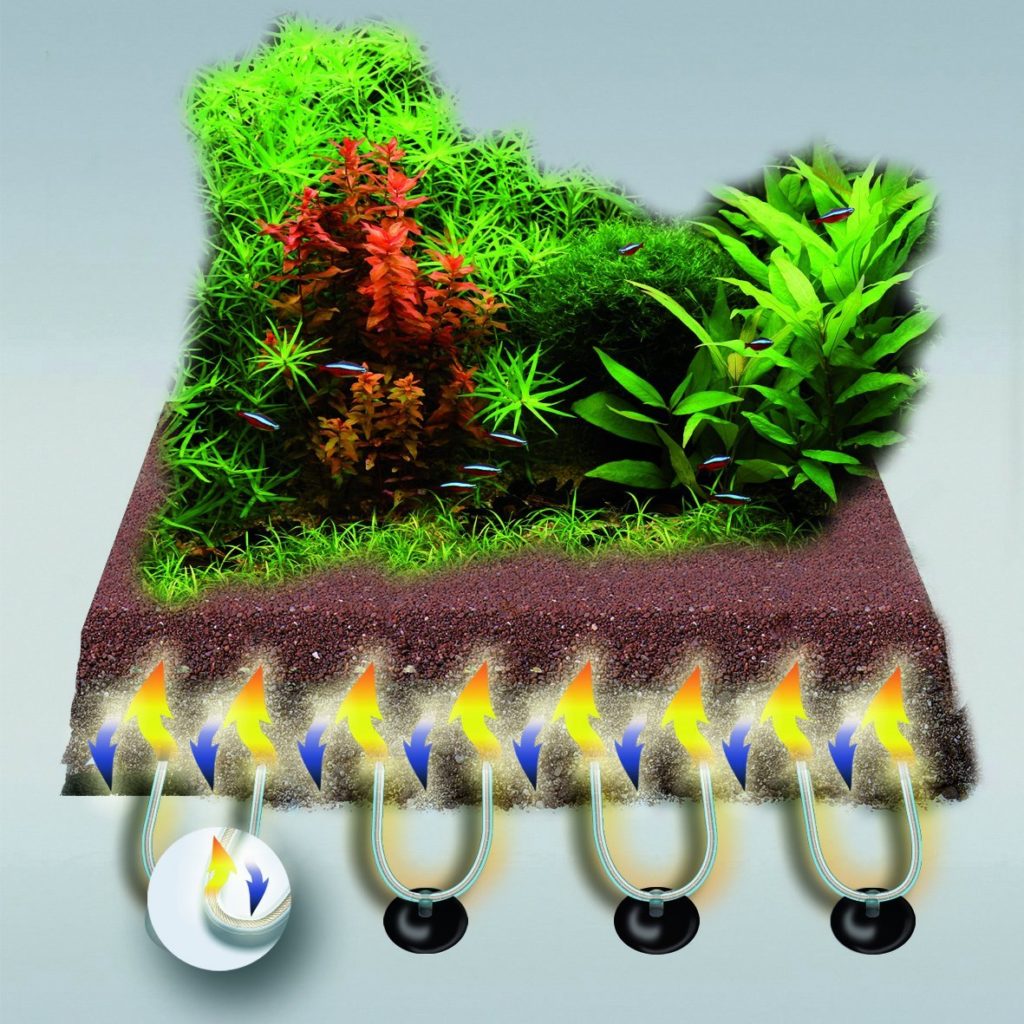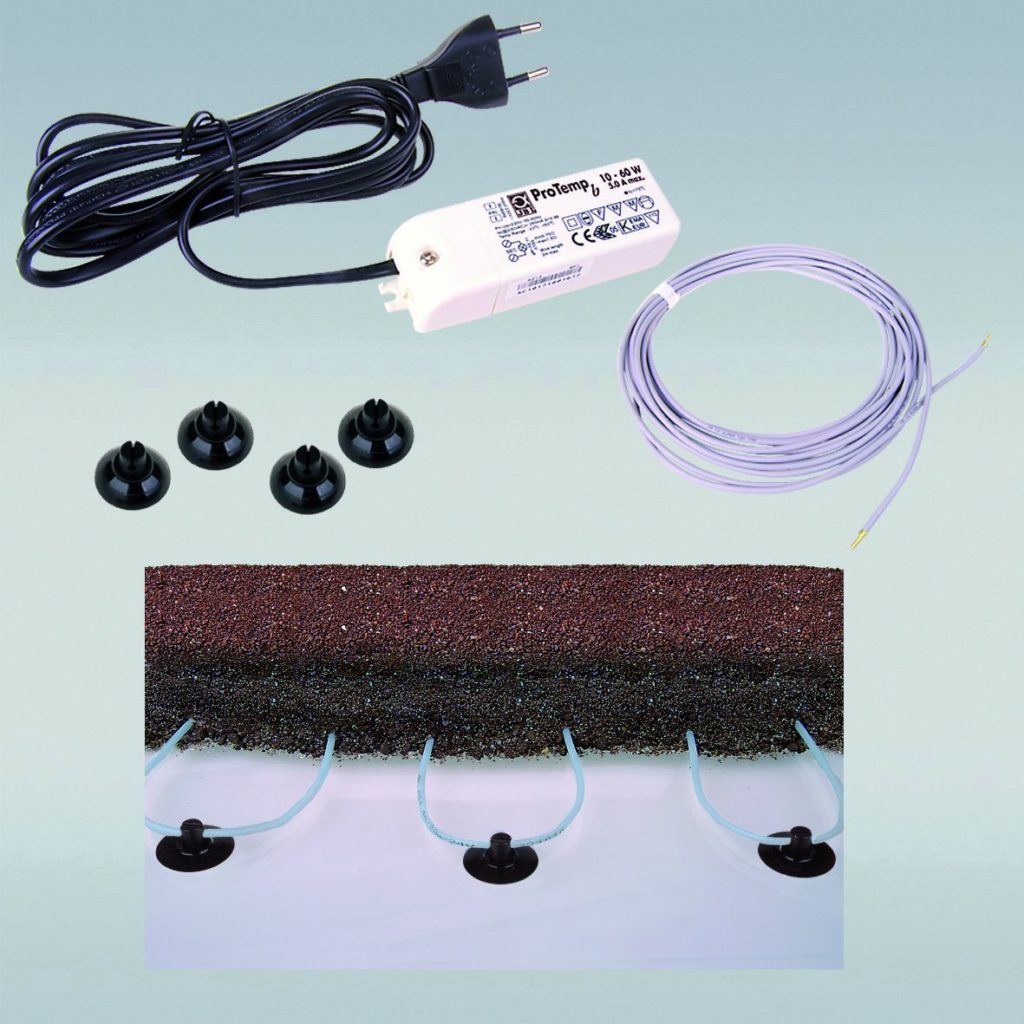With a floor wash and Floor heating and the Heat up the aquarium: In our big guide to Heating the aquarium water we have already presented the various possibilities. Today we want to take a closer look at a rather new form of heating and examine the advantages and disadvantages more closely. Buying a floor washer or floor heating is on the agenda of many aquarists today, although this step should not always be taken. The heating on the aquarium ground and floor should be well thought out and planned, then later only a few changes can be made here. But let's start at the beginning, what is a floor wash at all and what is this for? Is this even a heater?
What is a floor floodlight / floor heating anyway?
Let's start with an explanation of the terms, because beginners in particular, who have not yet dealt with the various heating technologies, will ask themselves what is meant by the Floor heating understands. Often the word floor wash called because it floods the aquarium through the bottom with a heat output. As the name suggests, the floor heating is installed on the bottom of the aquarium. There are two basic differences in the assembly and the assembly location. On the one hand, you can mount the floor heating outside of the aquarium on a kind of heating plate, and on the other hand, the floor washer is mounted directly on the floor of the aquarium. The second type is much more common.
No matter what you call it, you should know that it is usually only an auxiliary heating and not the sole heating. Many aquarists are also of the opinion that there is no heating at all, but only a flow of water. But more on that later.
- Mount the floor washer and floor heating under the aquarium pane outside
- Mount floor heating in the aquarium
The main disadvantage of mounting your floor heating under the aquarium pane is the heat loss through the glass. There are extremely large losses here, although one can say that there is an advantage, because with this you don't have a live device in the aquarium and you don't have to be careful when planting. However, this type of assembly is rather rare and we focus on the other type.
Advantages of underfloor heating?
Before we get to the structure and assembly, let's take a look at the crucial one Advantage one floor washers toss. Aquatic plants need nutrients and also the appropriate heat in the aquarium. If this comes from below, it floods the root area particularly well. This is also where most aquatic plants get their nutrients. Of course not only, because waterweed also takes over the leaves and co. needle ledges and Co their nutrients. Nevertheless, the heat that reaches the plants from below stimulates the absorption extremely and especially in planted aquariums you should think carefully about the possibility of a bottom floodlight.
In addition, the distribution of the heat is optimal, because it is distributed evenly over the entire aquarium from below. A problem that you usually have with the ordinary heating element. Here you have to ensure good circulation with the help of the filter.
| # | Preview | Products | Rating | Price | |
|---|---|---|---|---|---|
| 1 |  | JBL PROTEMP b60 III Modern floor heating | 87,36 EUR | View product | |
| 2 |  | Dennerle 1633 Eco-Line ThermoTronic 20 W | 33,00 EUR | View product | |
| 3 |  | JBL ProTemp b20 floor heating for freshwater and seawater aquariums, for 100 - 250 l | 79,79 EUR | View product |
Disadvantage of underfloor heating?
But where there are advantages, there are usually also disadvantages. In addition to a possible higher price and costs, there are also other costs for the regulation and control at. As a rule, the performance of a floor washer is not designed to heat up the entire aquarium water. An additional heating source is required here and this also results in additional costs. In addition, you have to regulate these two heating systems accordingly. This will also require another device.
We will tell you below why you need a special regulation.
If you manage to bring the aquarium to the desired water temperature with the floor washer alone, then you are only slightly above a conventional heater in terms of costs. In the Upkeep will only move a little, because the power for heating the water is basically the same, even if it is distributed over several devices.
The installation of the floor heating is certainly also a disadvantage, because basically this can only be used for a new installation or an initial installation. Retrofitting is probably no longer possible at a later date.
Construction and installation of underfloor heating
Now we come to the installation of underfloor heating. Basically, the floor heating consists of the following components:
- Heating cable and different lengths
- Suction cups for attachment to the glass
- transformer and control unit
- The regulation and control is usually not included in the scope of delivery
First, the heating cable is attached to the bottom of the aquarium in spirals and snake form. The suction cups are used for this. You should make sure that you don't leave out any areas. After that comes on this heater actual ground. You can find information about this here.
- Underfloor heating for near-natural, thermal flow through the substrate, promotion of plant growth through nutrient transport to the plant roots
- Water circulation in the ground for natural filtration by the colder water flowing in due to the rising, heated water
- Simple installation by laying the heating cable in loops on the bottom pane of the aquarium and then fixing it with suction cups
- More power from the heating cable thanks to the large cross-section, 24 V safety voltage for increased protection, high-quality power supply, spring clamps for tool-free installation
- Scope of delivery: 1x JBL floor heating cable for aquariums, JBL PROTEMP b60, heating cable: 9,0 m, power cable: 1,5 m, PTC thermistor: 2 m, slot sucker: 40, incl. electr. Transformer, mounting sucker, 6049300
- Turns the substrate into a biofilter
- energy saving
- 14 volt safety technology
- Underfloor heating for optimal plant growth in aquaria: natural, thermal flow through the water, promoting root formation and growth, for aquaria from 100 - 250 L (approx. 80 - 100 cm long)
- Easy installation: Lay out 4,9 m heating cable in loops on the bottom pane of the aquarium, fix with suction cups
- Biological filter: nutrient seepage sources like in nature - ideal supply for the plants, no fermentation gas formation due to standing water
- Energy-efficient and safe: silicone-coated heating cable with energy-saving, electronic 20 W transformer with 12 V safety extra-low voltage
- Scope of delivery: 1 x floor heating cable for JBL ProTemp aquariums, incl. electronic 20 W transformer, 4,9 m heating cable, 2x 2,0 m power cable, 30x fastening suckers, 60416
We have also attached corresponding assembly videos below.
The end of the heating cable is then best routed out of the aquarium at the rear and coupled and connected to the power and voltage supply there. Basically, it was already there and you can put the floor washer into operation.
In any case, you should carry out an initial function test. If you find out later that there is a problem, it is difficult to replace the cable again.
In order to be able to regulate them accordingly, another one is required steering. This can be either a aquarium computers or a simple one Timer be. The possible components are here:
Why do I need a controller for the bottom washlight?
Let us now turn to the explanation for the need for regulation. As you may have already noticed with the components, there is no thermostat on the floor washer that takes the temperature. This would always be switched on, which may result in a temperature that is too high. A normal control heater has one integrated thermostat and regulates itself with it. If you operate both together in the aquarium, you should have a common regulation. It is therefore also possible to switch certain scenarios. For example, the floor floodlight can be switched off every hour for a certain period of time.
Of course, you could also operate the floor washlight on a timer, but then you would only have a control over the time and not over the temperature. This would also be possible for cost reasons.
Here we present some models that would be suitable for regulation. Be it from Dennerle or from other manufacturers. Here are probably the best control models.
What is the heat output of underfloor heating?
As already mentioned above, the heat output of underfloor heating is usually not sufficient to bring all the water up to temperature. That's why one additional Heating source thats it!
The length of the heating cable usually depends on the heating output. With a length of 2 meters, for example, you will not be able to design a large aquarium. Here the length is simply not enough to lay out the entire floor accordingly. Of course you can also use several sets from the manufacturer and then connect them together.
For example, Dennerle has a set with 8 watts which should then be sufficient for around 100 liters of aquariums.
JBL, for example, goes about it with different sizes. Be it with sets of 50 - 120 liters, 100 - 250 liters and 200 - 400 liters. With large sets there is a 7 meter cable and the transformer manages an output of 40 watts. So you can of course lay out much more floor space accordingly.
Electricity consumption of the floor heating?
Basically, we have already answered the question above, but we still want to explain something here. Of course, the power consumption always depends on the duration of operation and the switch-on time. Basically, floor washlights are assumed to be in almost constant use. This must also be taken into account in the current calculation. But if you don't have this, then normal heating will consume more electricity for it. Basically, the electricity costs are only divided between two devices.
Conclusion and purchase recommendation Bodenfluter or floor heating
Anyone setting up a new aquarium today should definitely consider whether it makes sense to use this heating technology. Anyone who already has their aquarium in operation and it may set up newIf you want, you can also consider this heater. The Aquatic plants will thank you.
Our recommendation is definitely to think about this purchase. With a new aquarium, we would definitely take these additional costs into account.
We don't want to recommend a specific manufacturer here. However, you should pay attention to good quality, because a later exchange is definitely no longer possible.






